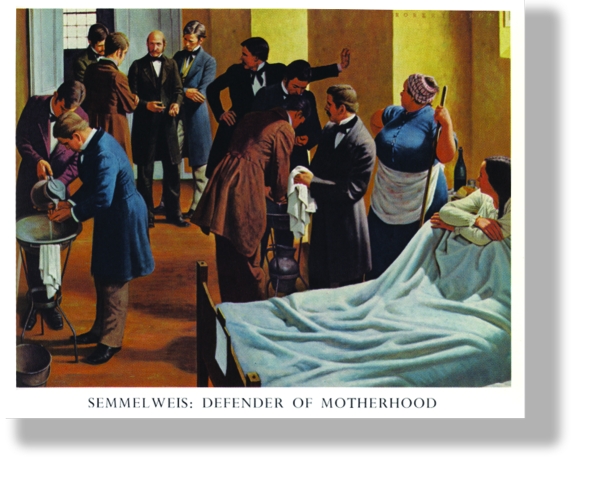IN THE EARLY TO MIDnineteenth century in Europe and America, thousands of young women died from childbed fever, also known as puerperal fever, a disease rampant in the charity maternity clinics of the time.1 Women were generally affected within the first three days after childbirth. The disease progressed rapidly and caused acute symptoms of severe abdominal pain, fever, and debility. Therapy usually involved bloodletting, but with or without this treatment the disease was often fatal. Perhaps Jane Seymour, the third wife of England's King Henry VIII, was the most famous victim of puerperal fever. She died two weeks after giving birth to Henry's only surviving son, the future Edward VI of England.
Two heroes in the fight against puerperal fever were Oliver Wendell Holmes and Ignaz Philipp Semmelweis. If Holmes now stands in Semmelweis's shadow, it is because Holmes's own medical reputation was largely eclipsed by the brilliant success he achieved in the fields of literature, poetry, and popular lectures.2 In the late nineteenth and early twentieth centuries, Holmes's literary and poetic works were reprinted in hundreds of editions by American and British publishers. Even his own profession came to value him more as a professor and poet than as a fearless and outspoken defender of the life and health of childbearing women.
In the late nineteenth century, Oliver Wendell Holmes was so popular that his image and lines from his poetry and prose appeared on items such as this calendar, as well as games, postcards, and gift books. Courtesy of Marilyn Barth and the National Library of Medicine, National Institutes of Health, Bethesda, MD.
Semmelwei s Defender of Motherhood. Courtesy of the National Library of Medicine, National Institutes of Health, Bethesda, MD.
Born into a family whose ancestors had distinguished themselves in both literature and medicine, Holmes attended Harvard University and also studied at the prestigious medical schools of Paris. After two and a half years, he returned to the United States and received his medical degree from Harvard in 1836. He maintained a small medical practice for 12 years but found that his main interests lay in teaching and research. Hearing of the death of a physician one week after performing a postmortem exam on a woman who had died of puerperal fever, Holmes began a thorough investigation and read a paper on “The Contagiousness of Puerperal Fever” before the Boston Society for Medical Improvement in 1843. Because the paper was published in the New England Quarterly Journal of Medicine and Surgery,3 a journal with a very small circulation which ceased publication after only one year, it went largely unnoticed until it was republished in 1855 as a booklet entitled Puerperal Fever, as a Private Pestilence.4 Holmes argued the controversial view that physicians with unwashed hands were responsible for transmitting puerperal fever from patient to patient. Holmes was promptly attacked by the leading Philadelphia obstetrician, Charles D. Meigs, who derided his arguments as the “jejeune and fizzenless dreamings” of a sophomoric writer, and declared that any practitioner who met with epidemic cases of puerperal fever was simply “unlucky.”5
A few years later, Semmelweis took up the struggle in Europe to persuade other physicians of the contagiousness of puerperal fever. Semmelweis completed his MD degree at the University of Vienna in 1844. In 1846, he was appointed assistant to Johannes Klein in the maternity clinic of the Vienna General Hospital. Semmelweis was puzzled to discover that the First Clinic of the Hospital had a much higher maternal mortality rate (10%) than the Second Clinic (less than 4%). The only difference he could find between the two clinics was that the first was used to train medical students whereas the second trained midwives. When his friend and colleague, Professor Jakob Kolletschka, died from septicemia from a finger injury acquired from a postmortem examination on a woman who had died of puerperal fever, Semmelweis concluded that he and his fellow physicians were carrying “cadaverous particles” from the autopsy rooms to the patients they examined in the First Clinic. The midwives, who were not involved in autopsies, had no such contact with corpses or “cadaverous particles.” Semmelweis began to insist that anyone attending autopsies scrub their hands in chloride of lime before entering the maternity wards. The maternal mortality rate immediately fell to that of the Second Clinic.6
Semmelweis soon became the focus of a fierce power struggle within the Vienna medical faculty as his work became the subject of a bitter dispute among European obstetricians. His arguments ran contrary to the disease theories of the time, that infections were due to “miasmas” or “bad air,” or to the balance of humors within a patient's body. In 1861, Semmelweis published Die Ätiologie, der Begriff und die Prophylaxis des Kindbettfiebers [The Etiology, Concept, and Prophylaxis of Childbed Fever].7 When his book was either ignored or ridiculed, Semmelweis began to denounce prominent European obstetricians as irresponsible murderers. He became depressed and started drinking; his public behavior became irritating and embarrassing to his professional colleagues and to his family. In 1865 he was deceived into entering an insane asylum and when he tried to escape, he was severely beaten by guards. A gangrenous wound to his hand, probably caused by the beating, led to his untimely death two weeks later.
Thanks to the work of Holmes and Semmelweis, the gradual acceptance of sterile procedures, and to a variety of other factors such as improved environmental conditions, better overall obstetrical care, and the availability of antibiotics, puerperal fever has become rare in developed countries. In time, with sufficient organization, political will, and dedication, maternal mortality will be very rare in all parts of the world.
References
- 1.Cutter IS, Viets HR, A Short History of Midwifery (Philadelphia; London: W. B. Saunders Company, 1964), 99 [Google Scholar]
- 2.“Physician at the Breakfast Table: Oliver Wendell Holmes as Popular Icon,” exhibition curated by Michael North, History of Medicine Division, National Library of Medicine, Bethesda, MD [Google Scholar]
- 3.Holmes OW, “The Contagiousness of Puerperal Fever,” New England Quarterly Journal of Medicine and Surgery 1 (1943): 503–521 [Google Scholar]
- 4.Holmes OW, Puerperal Fever as a Private Pestilence (Boston, MA: Ticknor and Fields, 1855). [Google Scholar]
- 5.Dowling WC, Oliver Wendell Holmes in Paris: Medicine, Theology, and The Autocrat of the Breakfast Table (Durham, NH: University of New Hampshire Press, 2006), 95 [Google Scholar]
- 6.Semmelweis IF, The Etiology, Concept, and Prophylaxis of Childbed Fever, trans. and ed Carter KC. (Madison, WI: University of Wisconsin Press, 1983), 20 [Google Scholar]
- 7.Semmelweis IF, Die Ätiologie, der Begriff und die Prophylaxis des Kindbettfiebers (Pest: Hartleben, 1961). [Google Scholar]




